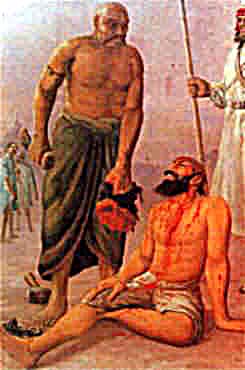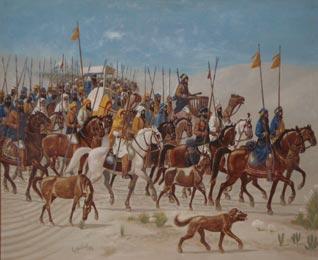Discover the valiant story of Taru Singh, a Sikh martyr from Punjab who selflessly supported exiled brethren. His legacy of faith endures.
Discover the legacy of Sodhi Vadbhag Singh, a descendant of Guru Hargobind, who led Sikh resistance against Afghan oppression in 18th-century Punjab.
Discover the tumultuous reign of Yar Muhammad Khan in Peshawar, his struggles with Ranjit Singh, and alliances amidst regional power shifts.
AHWAL-I-FIRQAH-I-SIKKHAN, variously titled as Twarikh-i-Sikkhan, Kitab-i-Tankhi-Sikkhan and Guzarish-i-Ahwal-i-Si\'kkhan, by Munshi Khushwaqt Rai, is a history in Persian of the Sikhs from their origin to AD 1811. Khushwaqt Rai was an official news writer of the East India Company accredited to the Sikh city of Amritsar. It was written at the request of Col (afterwards General Sir) David Ochterlony, British political agent at Ludhiana on the Anglo Sikh frontier. Opinion also exists that it was written at the suggestion of Charles Theophilus Metcalfe.
ANDREWS, CHARLES FREER (1871-1940). Anglican missionary, scholar and educationist, was born to John Edwin Andrews on 12 February 1871 in NewcastleonTyne in Great Britain. His father was a minister of the Evangelical Anglican Church. Andrews grew up in an intense and emotional religious environment. A nearly fatal attack of rheumatic fever in childhood drew him to his mother with an intense affection and her love created in his mind the first conscious thoughts of God and Christ, and by the time he entered Cambridge, at the age of 19, he had already had "a wonderful conversion of my heart to God." In 1893, Andrews graduated first class in Classics and Theology from Pembroke College, Cambridge.
Discover the vibrant Baisakhi festival, marking the Sikh Khalsa's birth and harvest joy with dance, music, and rituals every April 13 or 14. Celebrate Sikh traditions!
BUDDHA DAL and Taruna Dal, names now appropriated by two sections of the Nihang Sikhs, were the popular designations of the two divisions of Dal Khalsa, the confederated army of the Sikhs during the eighteenth century. With the execution of Banda Singh Bahadur in 1716, the Sikhs were deprived of a unified command. Moreover, losses suffered by the Sikhs during the anti Banda Singh campaign around Gurdaspur and the relentless persecution that followed at the hands of `Abd usSamad Khan, governor of Lahore, made it impossible for Sikhs to continue large scale combined operations.









